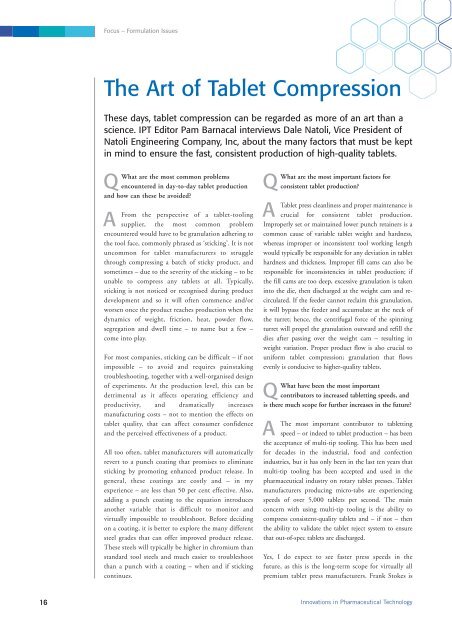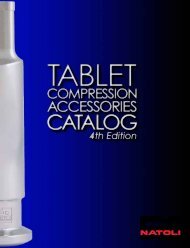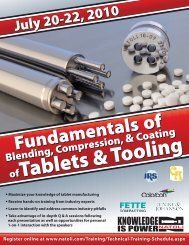The Art of Tablet Compression - Natoli Engineering
The Art of Tablet Compression - Natoli Engineering
The Art of Tablet Compression - Natoli Engineering
Create successful ePaper yourself
Turn your PDF publications into a flip-book with our unique Google optimized e-Paper software.
16<br />
Focus – Formulation Issues<br />
<strong>The</strong> <strong>Art</strong> <strong>of</strong> <strong>Tablet</strong> <strong>Compression</strong><br />
<strong>The</strong>se days, tablet compression can be regarded as more <strong>of</strong> an art than a<br />
science. IPT Editor Pam Barnacal interviews Dale <strong>Natoli</strong>, Vice President <strong>of</strong><br />
<strong>Natoli</strong> <strong>Engineering</strong> Company, Inc, about the many factors that must be kept<br />
in mind to ensure the fast, consistent production <strong>of</strong> high-quality tablets.<br />
Q<br />
What are the most common problems<br />
encountered in day-to-day tablet production<br />
and how can these be avoided?<br />
A<br />
From the perspective <strong>of</strong> a tablet-tooling<br />
supplier, the most common problem<br />
encountered would have to be granulation adhering to<br />
the tool face, commonly phrased as ‘sticking’. It is not<br />
uncommon for tablet manufacturers to struggle<br />
through compressing a batch <strong>of</strong> sticky product, and<br />
sometimes – due to the severity <strong>of</strong> the sticking – to be<br />
unable to compress any tablets at all. Typically,<br />
sticking is not noticed or recognised during product<br />
development and so it will <strong>of</strong>ten commence and/or<br />
worsen once the product reaches production when the<br />
dynamics <strong>of</strong> weight, friction, heat, powder flow,<br />
segregation and dwell time – to name but a few –<br />
come into play.<br />
For most companies, sticking can be difficult – if not<br />
impossible – to avoid and requires painstaking<br />
troubleshooting, together with a well-organised design<br />
<strong>of</strong> experiments. At the production level, this can be<br />
detrimental as it affects operating efficiency and<br />
productivity, and dramatically increases<br />
manufacturing costs – not to mention the effects on<br />
tablet quality, that can affect consumer confidence<br />
and the perceived effectiveness <strong>of</strong> a product.<br />
All too <strong>of</strong>ten, tablet manufacturers will automatically<br />
revert to a punch coating that promises to eliminate<br />
sticking by promoting enhanced product release. In<br />
general, these coatings are costly and – in my<br />
experience – are less than 50 per cent effective. Also,<br />
adding a punch coating to the equation introduces<br />
another variable that is difficult to monitor and<br />
virtually impossible to troubleshoot. Before deciding<br />
on a coating, it is better to explore the many different<br />
steel grades that can <strong>of</strong>fer improved product release.<br />
<strong>The</strong>se steels will typically be higher in chromium than<br />
standard tool steels and much easier to troubleshoot<br />
than a punch with a coating – when and if sticking<br />
continues.<br />
Q<br />
A<br />
What are the most important factors for<br />
consistent tablet production?<br />
<strong>Tablet</strong> press cleanliness and proper maintenance is<br />
crucial for consistent tablet production.<br />
Improperly set or maintained lower punch retainers is a<br />
common cause <strong>of</strong> variable tablet weight and hardness,<br />
whereas improper or inconsistent tool working length<br />
would typically be responsible for any deviation in tablet<br />
hardness and thickness. Improper fill cams can also be<br />
responsible for inconsistencies in tablet production; if<br />
the fill cams are too deep, excessive granulation is taken<br />
into the die, then discharged at the weight cam and recirculated.<br />
If the feeder cannot reclaim this granulation,<br />
it will bypass the feeder and accumulate at the neck <strong>of</strong><br />
the turret; hence, the centrifugal force <strong>of</strong> the spinning<br />
turret will propel the granulation outward and refill the<br />
dies after passing over the weight cam – resulting in<br />
weight variation. Proper product flow is also crucial to<br />
uniform tablet compression; granulation that flows<br />
evenly is conducive to higher-quality tablets.<br />
Q<br />
What have been the most important<br />
contributors to increased tabletting speeds, and<br />
is there much scope for further increases in the future?<br />
A<br />
<strong>The</strong> most important contributor to tabletting<br />
speed – or indeed to tablet production – has been<br />
the acceptance <strong>of</strong> multi-tip tooling. This has been used<br />
for decades in the industrial, food and confection<br />
industries, but it has only been in the last ten years that<br />
multi-tip tooling has been accepted and used in the<br />
pharmaceutical industry on rotary tablet presses. <strong>Tablet</strong><br />
manufacturers producing micro-tabs are experiencing<br />
speeds <strong>of</strong> over 5,000 tablets per second. <strong>The</strong> main<br />
concern with using multi-tip tooling is the ability to<br />
compress consistent-quality tablets and – if not – then<br />
the ability to validate the tablet reject system to ensure<br />
that out-<strong>of</strong>-spec tablets are discharged.<br />
Yes, I do expect to see faster press speeds in the<br />
future, as this is the long-term scope for virtually all<br />
premium tablet press manufacturers. Frank Stokes is<br />
Innovations in Pharmaceutical Technology
elieved to be the engineer responsible for designing<br />
the rotary tablet press during his employment with<br />
Parke Davis in the late 1800s. <strong>The</strong> same basic design<br />
– using cams to vertically move the tooling through<br />
the various cycles <strong>of</strong> tablet compression in a turret,<br />
with upper and lower punches and dies – is still used<br />
today. <strong>The</strong> first rotary tablet presses produced 400 to<br />
600 tablets a minute, whereas the modern tablet<br />
presses <strong>of</strong> today can produce more than 100,000<br />
tablets per minute. Innovation is simply matter <strong>of</strong><br />
time.<br />
Q<br />
A<br />
How important is choice <strong>of</strong> excipient in<br />
determining tablet quality?<br />
Choosing the proper excipient is crucial, and plays<br />
a big role in overall tablet quality. Dissolution,<br />
friability and hardness can all be affected. Press speed due<br />
to granulation flow and overall manufacturing efficiency<br />
are also a concern.<br />
Q<br />
A<br />
How does the granulation process contribute to<br />
tablet quality?<br />
Proper granulation is essential for overall tablet<br />
quality. Problems such as sticking, picking, poor<br />
hardness, friability and product flow can result from<br />
improper granulating. As a consequence, excessive fines<br />
can be formed, resulting in tabletting problems such as<br />
tool binding, product scorching or discoloration, and<br />
excessive tool and press wear. This seems to be a<br />
common issue with tablet manufacturers today, as dry<br />
direct compression blends have become the preferred<br />
method. Over-blending a granulation is another<br />
concern that is generally overlooked and can occur in<br />
the tablet press itself. <strong>The</strong> rotary force feeder <strong>of</strong> the<br />
tablet press should always be considered as a mini<br />
blender. <strong>The</strong> feeder paddles aggressively move the<br />
granulation into the die bores, and if the feeders are<br />
overfilled and/or run at too high a speed, the<br />
granulation continues to be blended. This can result in<br />
the over-blending <strong>of</strong> what may have been a good<br />
granulation.<br />
Q<br />
What have been the most significant<br />
advances in tablet compression tooling over<br />
the past decade, and how have these contributed<br />
to tabletting efficiency?<br />
A<br />
In the past decade – other then multi-tip tooling<br />
as mentioned earlier – the most significant<br />
advances have been the Fette Die segments, and the<br />
Courtoy die ring and die shells.<br />
www.iptonline.com<br />
In the past decade, Fette has developed a turret<br />
configuration that eliminates the use <strong>of</strong> traditional dies<br />
and die-locks that hold the dies secure in the die table.<br />
<strong>The</strong> die segments have two major benefits. First, they<br />
increase the number <strong>of</strong> stations in a given diameter <strong>of</strong> a<br />
turret, thereby increasing the number <strong>of</strong> tablets<br />
produced per turret revolution. Second, they<br />
dramatically reduce tablet press set-up time by<br />
eliminating the lengthy and painstaking process <strong>of</strong><br />
setting each die in position. Instead <strong>of</strong> handling,<br />
cleaning and maintaining individual dies, the die<br />
segments require two bolts per segment and are locked<br />
positively in place, while maintaining the proper<br />
alignment <strong>of</strong> the punches into the segment bore.<br />
<strong>The</strong> Courtoy die ring also has advantages over<br />
conventional dies and is more versatile as it allows the<br />
use <strong>of</strong> traditional dies, or alternatively a unique die<br />
configuration called die shells that are held in position<br />
without the use <strong>of</strong> traditional die locks. Unlike the<br />
Fette die segments, the Courtoy system uses a singlepiece<br />
replaceable die ring that substitutes for the<br />
traditional die table <strong>of</strong> a turret. To remove and replace<br />
the die ring, the turret’s upper and lower section<br />
separates allowing unrestricted access to the die ring<br />
for removal and installation. Again, increasing the<br />
number <strong>of</strong> stations in a given diameter <strong>of</strong> a turret<br />
increases the number <strong>of</strong> tablets produced per turret<br />
revolution, while use <strong>of</strong> the die ring instead <strong>of</strong><br />
conventional dies and die locks dramatically reduces<br />
press set-up time.<br />
Q<br />
<strong>Tablet</strong> press tooling comes in a variety <strong>of</strong><br />
sizes and materials. How does this affect the<br />
finished tablet?<br />
A<br />
A variety <strong>of</strong> sizes and configurations are<br />
available, with each configuration having a<br />
unique benefit. <strong>The</strong> most common configurations are<br />
the ‘B’ and ‘D’ types, which are available in the<br />
American and European cam format. <strong>The</strong> ‘B’ type is<br />
smaller in scale than the ‘D’ type and is considered the<br />
most common; it is used by virtually all<br />
pharmaceutical tablet manufacturers. In general, the<br />
different configurations are determined by the<br />
maximum available tonnage, and the output or speed<br />
<strong>of</strong> a tablet press due to fewer tooling stations in a given<br />
turret diameter.<br />
<strong>Tablet</strong> compression tooling is also available in a<br />
variety <strong>of</strong> materials. In order to maintain efficiency,<br />
it is advisable to evaluate several steel types to<br />
determine which material will be best suited for a<br />
17
18<br />
particular product. High chromium steels tend to be<br />
preferred over standard steel for better product release,<br />
but it does have a tendency to be more brittle – and so<br />
is not best suited for some tablet shapes or<br />
granulations requiring excessively high compression<br />
tonnage.<br />
Q<br />
Which types <strong>of</strong> product are most suitable for<br />
multi-tip tooling and to what extent can this<br />
improve tabletting efficiency?<br />
A<br />
Most products are suited to multi-tip tooling<br />
technology. Considerations include tablet size,<br />
compression force, product sticking, ejection force and<br />
the overall condition <strong>of</strong> the tablet press. Multi-tip<br />
tooling provides a substantial increase in production,<br />
resulting in a highly efficient tabletting programme. In<br />
most cases, a tablet manufacturer can expect an increase<br />
in output <strong>of</strong> approximately 80 per cent for each<br />
additional tip. For example, if a press is producing<br />
3,500 tablets per minute, then by adding an additional<br />
tip the output will be 6,300 tablets per minute, and the<br />
addition <strong>of</strong> a further tip will raise output to<br />
approximately 9,100 tablets per minute.<br />
Q<br />
A<br />
What are the advantages <strong>of</strong> using Micro-tab<br />
punches?<br />
Micro Tab tooling is a unique tool configuration,<br />
engineered to reduce distortion or breaking <strong>of</strong> the<br />
punch tips – as occurs more commonly with the lower<br />
punch. <strong>The</strong> micro-tip configuration should be<br />
considered for all tablets under 4 mm in diameter, and<br />
for tablets <strong>of</strong> 5 mm or smaller requiring an excessively<br />
high compression force.<br />
<strong>The</strong> micro-tab tool configuration shortens the upper<br />
and lower punch tips in order to gain strength, making<br />
Dale <strong>Natoli</strong> is Vice President <strong>of</strong> <strong>Natoli</strong> <strong>Engineering</strong><br />
Company, Inc (Saint Charles, MO, USA). He has over 35<br />
years <strong>of</strong> experience worldwide in the tablet compression<br />
industry, and has authored many articles and book chapters<br />
on the subject <strong>of</strong> tablet compression. In addition, he has<br />
chaired and served as a board member for revisions to the<br />
Third Edition <strong>of</strong> the ‘<strong>Tablet</strong> Specification Manual’ sponsored<br />
by the American Pharmaceutical Association. Currently, he presents lectures<br />
for universities, pharmaceutical associations and tablet manufacturers in the<br />
US, Europe and Asia; his areas <strong>of</strong> expertise include tablet design, tool<br />
configurations and troubleshooting. Dale is the driving force behind<br />
establishing new technologies and special tool configurations for the tablet<br />
compression industry. He continuously works to enhance tablet production<br />
and quality, and extend tool life. Email: ???<br />
the punch tips more robust. In order to shorten the<br />
lower tip, a special undercut must be machined in the<br />
bottom <strong>of</strong> the die to accept a portion <strong>of</strong> the smaller<br />
punch barrel in order to have the proper tip length for<br />
tablet ejection.<br />
Q<br />
A<br />
What sorts <strong>of</strong> procedures can be used for<br />
cleaning compression tooling?<br />
Proper cleaning <strong>of</strong> compression tooling can be a<br />
long and tedious task. Many tablet manufacturers<br />
that need to clean several sets <strong>of</strong> tooling per day have<br />
implemented expensive and automated washing systems<br />
equipped with hot air drying to reduce spotting and<br />
surface corrosion. Regardless <strong>of</strong> the method used, the<br />
most important factor is to use a cleaning agent suited<br />
for carbon tool steels. <strong>The</strong> use <strong>of</strong> hot water for rinsing<br />
elevates the temperature <strong>of</strong> the tooling to aid in the<br />
immediate drying process and reducing the possibility <strong>of</strong><br />
surface discoloration and spotting.<br />
Q<br />
A<br />
What is ‘tablet land’ and what are the reasons<br />
for incorporating it into a tablet design?<br />
<strong>Tablet</strong> land generally has the appearance <strong>of</strong> a<br />
small flat ridge around the perimeter <strong>of</strong> a tablet.<br />
Sometimes, it can be confused with poor quality<br />
tablets, which have a small raised crown around the<br />
tablet perimeter; this is commonly referred to as<br />
‘flashing’. Passing tablets through a vibrating machine<br />
called a de-duster helps to remove the s<strong>of</strong>t feather edge,<br />
reducing dust accumulation during packaging and edge<br />
attrition during the coating process. <strong>The</strong> degree <strong>of</strong><br />
flashing is dependent on punch and die clearance, tool<br />
wear, particle size and tablet design. <strong>The</strong>re is a<br />
misconception regarding land as an undesirable<br />
attribute – especially for film-coated tablets – whereas<br />
in fact it is just the opposite. Designing land into a<br />
tablet design will help to strengthen the edge <strong>of</strong> the<br />
tablet, allowing for easier film coating and extending<br />
tool life.<br />
Q<br />
Given the current economic climate, is there<br />
much scope or demand for refurbishing existing<br />
tablet presses?<br />
A<br />
Yes – and demand for refurbishing existing tablet<br />
presses is steadily increasing as tablet<br />
manufacturers consider alternative options to purchasing<br />
costly new equipment. Some tablet manufactures are<br />
even trying to change the format <strong>of</strong> a tablet press from<br />
‘D’ type to ‘B’ type in order to provide more tablets per<br />
revolution – thereby increasing tablet output.<br />
Innovations in Pharmaceutical Technology




